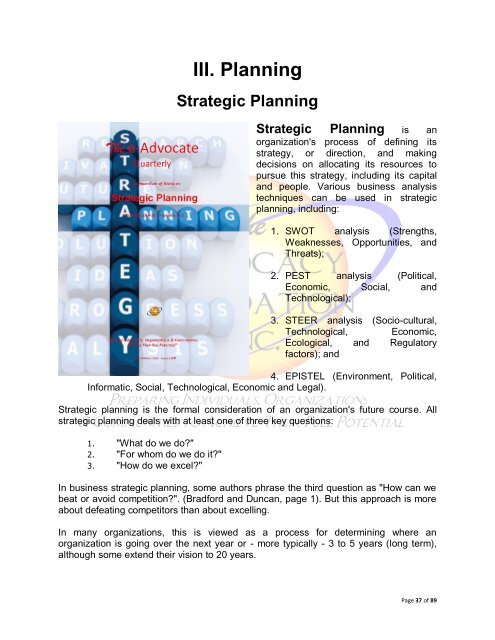The EDTC Incubator
The EDTC Incubator
The EDTC Incubator
You also want an ePaper? Increase the reach of your titles
YUMPU automatically turns print PDFs into web optimized ePapers that Google loves.
III. Planning<br />
Strategic Planning<br />
Strategic Planning is an<br />
organization's process of defining its<br />
strategy, or direction, and making<br />
decisions on allocating its resources to<br />
pursue this strategy, including its capital<br />
and people. Various business analysis<br />
techniques can be used in strategic<br />
planning, including:<br />
1. SWOT analysis (Strengths,<br />
Weaknesses, Opportunities, and<br />
Threats);<br />
2. PEST analysis (Political,<br />
Economic, Social, and<br />
Technological);<br />
3. STEER analysis (Socio-cultural,<br />
Technological, Economic,<br />
Ecological, and Regulatory<br />
factors); and<br />
4. EPISTEL (Environment, Political,<br />
Informatic, Social, Technological, Economic and Legal).<br />
Strategic planning is the formal consideration of an organization's future course. All<br />
strategic planning deals with at least one of three key questions:<br />
1. "What do we do?"<br />
2. "For whom do we do it?"<br />
3. "How do we excel?"<br />
In business strategic planning, some authors phrase the third question as "How can we<br />
beat or avoid competition?". (Bradford and Duncan, page 1). But this approach is more<br />
about defeating competitors than about excelling.<br />
In many organizations, this is viewed as a process for determining where an<br />
organization is going over the next year or - more typically - 3 to 5 years (long term),<br />
although some extend their vision to 20 years.<br />
Page 37 of 89

















